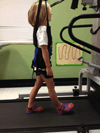Body Weight Support Treadmill Training for Children With Developmental Delay Who Are Ambulatory
- PMID: 26397083
- PMCID: PMC4580974
- DOI: 10.1097/PEP.0000000000000172
Body Weight Support Treadmill Training for Children With Developmental Delay Who Are Ambulatory
Abstract
Purpose: To examine the effect of body weight-supported treadmill training (BWSTT) on gait and gross motor skill development in children (2-5 years old) with developmental delay who are ambulatory.
Methods: Twenty-four subjects (12 control and 12 BWSTT) were enrolled in this randomized control trial. All subjects continued to receive physical therapy. Subjects were tested at baseline, 4 weeks, 6 weeks, and at 6 weeks after completion of BWSTT. Outcomes were assessed using the 10-m walk test and Gross Motor Function Measure-D and E.
Results: Significant improvements were seen in gait velocity and gross motor skill attainment. With positive interactions in both the 10-m walk test and Gross Motor Function Measure-E, the BWSTT group as compared with the control group demonstrated functional gains in gait velocity and gross motor skills, P = .033 and .017, respectively.
Conclusions: A 6-week high-intensity BWSTT program can improve gait velocity and influence functional gains.
Conflict of interest statement
Conflict of Interest Statement: The authors declare no conflict of interest.
Figures
Comment in
-
Commentary on "Body Weight Support Treadmill Training for Children With Developmental Delay Who Are Ambulatory".Pediatr Phys Ther. 2015 Winter;27(4):395. doi: 10.1097/PEP.0000000000000182. Pediatr Phys Ther. 2015. PMID: 26397084 No abstract available.
References
-
- Sacker A, Quigley MA, Kelley YJ. Breastfeeding and developmental delay: findings from the millennium cohort study. Pediatrics. 2006;118(3):682–689. - PubMed
-
- Caniato RN, Stich HL, Baune BT. Increasing prevalence of motor impairments in preschool children from 1997–2009: results of the Bavarian pre-school morbidity survey. International Research Journals. 2011;2:1409–1416.
-
- Cantell MH, Smyth MM, Ahonen TP. Clumsiness in adolescence: educational, motor, and social outcomes of motor delay detected at 5 years. Adapted Physical Activity Quarterly. 1994;11:115–129.
-
- Majnemer A. Benefits of Early Intervention for Children With Developmental Disabilities. Seminars In Pediatric Neurology. 1998;5(1):62–69. - PubMed
-
- Campbell SK, Palisano RJ, Orlin MN. Physical Therapy for Children. 4th Edition. St. Louis, MO: Elsevier Saunders; 2012. pp. 175–204.
Publication types
MeSH terms
Grants and funding
LinkOut - more resources
Full Text Sources
Medical






